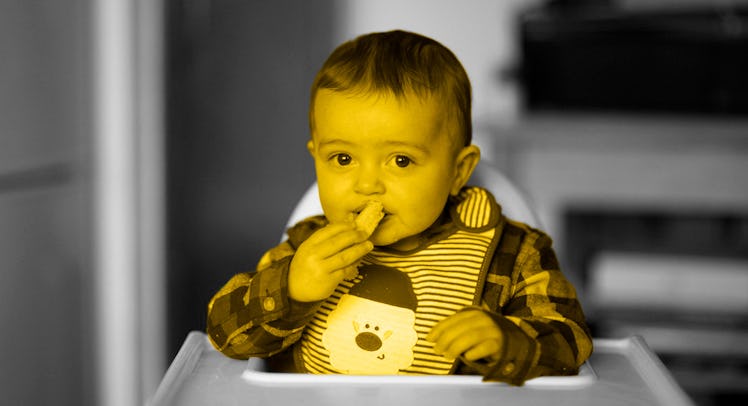How to Introduce Young Children to Finger Foods (Without the Mess)
To start your baby on solid foods let them take the lead. Finger foods will help them develop an understanding of the mechanics of eating as well as new textures and flavors.

Baby-led weaning banks on the ease of finger foods to help a baby transition from liquid nourishment like breast milk and formula to a life of delicious solid foods. But it can be hard to tell when a baby is ready for their first baby-led weaning foods. It’s even harder to understand which baby-led weaning first foods to give them. Luckily there are some basic guidelines that ensure when parents do start giving finger foods they set their kid up for a lifetime of good habits and healthy eating, while also avoiding the awful fate of raising a picky eater.
Of course, the first hurdle for parents is understanding when to start offering finger foods. There aren’t really any specific rules on age because, frankly, every child is different. Knowing when to start feeding baby solids is more about understanding the signs that they’re ready, willing and able to start branching out from a liquid diet. “Typically it’s around six months, but you want to look for developmental signs of feeding readiness that can vary from baby to baby,” explains Registered Dietitian Nutritionist Crystal Karges. “The baby should be able to sit up independently, they should be able to grasp items with good hand control and be able to put things in their mouth.”
Understanding Baby Led Weaning
- Babies are ready to start trying finger foods when they are able to sit up and grab food.
- When they’re ready to transition to finger foods, many babies will start showing an interest in what’s on mom and dads plate.
- Avoid soft starter foods and go straight for whole foods like bananas avocados and scrambled eggs.
- Safety is a concern, so avoid ball-shaped or coin-shaped foods that could be a choking hazard.
- Establish a routine and make sure you model good nutrition.
But, parents don’t always get the timing down right. They may get nervous about their child’s development and try to start solids too soon. “Trusting your babies feeding cues,” says Karges. “If food is being offered before they’re developmentally ready you’ll see them pushing out the food with their tongue, particularly purees if parents are spoon feeding.”
Once it seems a kid is ready to make the leap to solids, Karges notes that most of their nutrition is still coming from breast milk or formula. So it’s important not to cut them off from their previous diet. Essentially finger foods are going to be supplemental. And largely, they’re less about nutrition than they are about helping a kid understand the basics — understanding the mechanics of moving the hand to mouth, getting used to moving food around with the tongue and exploring new textures and flavors. To that end, Karges recommends parents stay away from bland cereals. “I like to encourage parents to feed babies whole foods,” she says. “First foods can include anything that is soft to squish in gums and mouth. I encourage parents to aim for nutrient-rich foods.”
What are the best finger foods for baby according to Karges? She recommends bananas, steamed sweet potatoes, avocado, and even scrambled egg. As they progress, she even suggests parents begin spicing foods. “It’s wonderful to include some minimal spices to introduce their palate to new flavors,” she says. “You can add stuff like cinnamon to cooked oats or the sweet potato, or maybe a little paprika. This encourages baby to get used to different flavors and helps decrease the risk of picky eating down the road.”
Offering a diversity of foods is just one good habit to start when babies pick up solids. Parents will also set their kid up for a healthy future by creating a dinner routine in which the entire family eats together. Not only does eating dinner with a child help them develop a routine, it shows them that mom and dad eat a wide variety of delicious fruits and vegetables, setting the baby up for healthy eating habits.
Because there’s always a learning curve when a baby is trying something new, like finger foods, it’s important that parents also keep safety in mind. “Never leave a baby unattended and making sure they can sit upright,” Karges notes. “Also avoid foods that increase the risk of choking, like whole grapes, whole cherry tomatoes, thick nut butters, hard crusty bread and any food in a coin-like shape.”
This article was originally published on